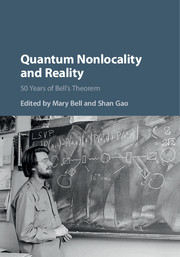Book contents
- Frontmatter
- Contents
- Contributors
- Preface
- Preface
- Part I John Stewart Bell: The Physicist
- Part II Bell's Theorem
- Part III Nonlocality: Illusion or Reality?
- Part IV Nonlocal Realistic Theories
- 19 Local Beables and the Foundations of Physics
- 20 John Bell's Varying Interpretations of Quantum Mechanics: Memories and Comments
- 21 Some Personal Reflections on Quantum Nonlocality and the Contributions of John Bell
- 22 Bell on Bohm
- 23 Interactions and Inequality
- 24 Gravitation and the Noise Needed in Objective Reduction Models
- 25 Towards an Objective Physics of Bell Nonlocality: Palatial Twistor Theory
- 26 Measurement and Macroscopicity: Overcoming Conceptual Imprecision in Quantum Measurement Theory
- Index
- References
21 - Some Personal Reflections on Quantum Nonlocality and the Contributions of John Bell
from Part IV - Nonlocal Realistic Theories
Published online by Cambridge University Press: 05 September 2016
- Frontmatter
- Contents
- Contributors
- Preface
- Preface
- Part I John Stewart Bell: The Physicist
- Part II Bell's Theorem
- Part III Nonlocality: Illusion or Reality?
- Part IV Nonlocal Realistic Theories
- 19 Local Beables and the Foundations of Physics
- 20 John Bell's Varying Interpretations of Quantum Mechanics: Memories and Comments
- 21 Some Personal Reflections on Quantum Nonlocality and the Contributions of John Bell
- 22 Bell on Bohm
- 23 Interactions and Inequality
- 24 Gravitation and the Noise Needed in Objective Reduction Models
- 25 Towards an Objective Physics of Bell Nonlocality: Palatial Twistor Theory
- 26 Measurement and Macroscopicity: Overcoming Conceptual Imprecision in Quantum Measurement Theory
- Index
- References
Summary
Abstract
I present the background of the Bohm approach that led John Bell to a study of quantum nonlocality, from which his famous inequalities emerged. I recall the early experiments done at Birkbeck with the aim of exploring the possibility of ‘spontaneous collapse’, a way suggested by Schrödinger to avoid the conclusion that quantum mechanics is grossly nonlocal. I also review some of the work that John did which directly impinged on my own investigations into the foundations of quantum mechanics and report some new investigations towards a more fundamental theory.
Introduction
My first encounter with quantum nonlocality was in discussions with David Bohm when I joined him as an assistant lecturer at Birkbeck in the sixties. Although my PhD thesis had been in condensed matter physics under the supervision of Cyril Domb, I had always been fascinated and puzzled by quantum phenomena, and when the opportunity to study the subject with Bohm came up, I took it. I would listen to the discussions between Bohm and Roger Penrose, who was at Birkbeck at the time, and it soon became clear that the prescribed interpretation of quantum mechanics that I was taught as an undergraduate left too many questions unanswered.
At that time there was a very strange atmosphere in the physics community. I was often informed that there were no problems with the interpretation of the quantum formalism. If I did not follow the well-prescribed rules of the quantum algorithm, I would be ‘wasting my time’. There was no alternative, just do it! But Louis de Broglie and David Bohm had shown there was another way. However, their views were strongly opposed by many, and as far as I could judge their reasons did not seem to be based on mathematics or on logic, but on a preconceived notion that the formalism was, in principle, the best we could do. The experimental data were bizarre when looked upon from the standpoint of classical physics, but the uncertainty principle somehow prevented us from examining the actual process in detail. Reality was somehow veiled (see [1]).Were we condemned to use a mere algorithm or was there an underlying ontology?
- Type
- Chapter
- Information
- Quantum Nonlocality and Reality50 Years of Bell's Theorem, pp. 344 - 362Publisher: Cambridge University PressPrint publication year: 2016



